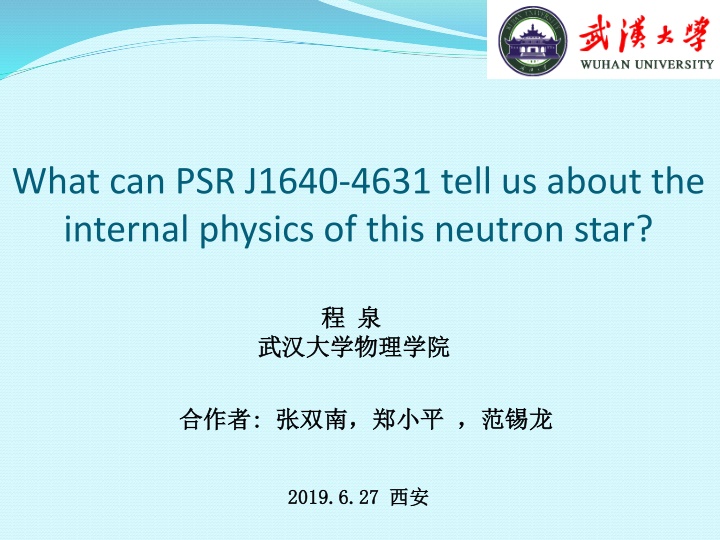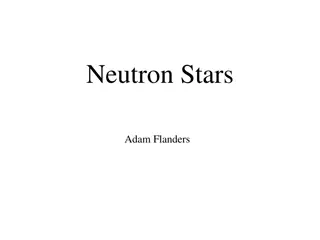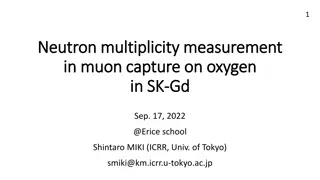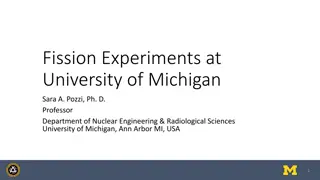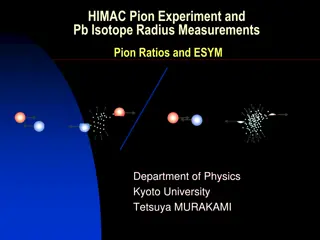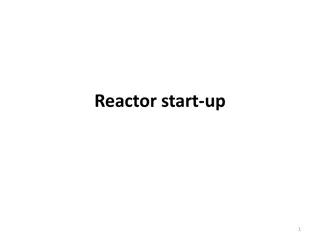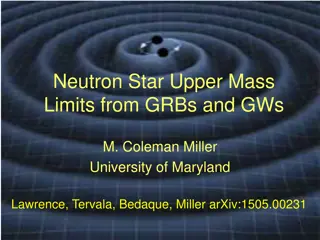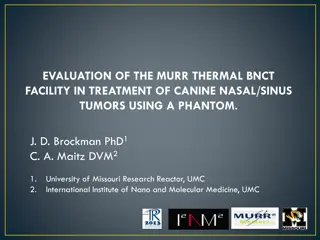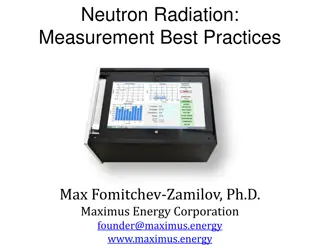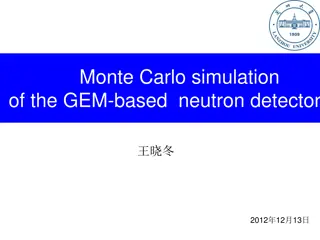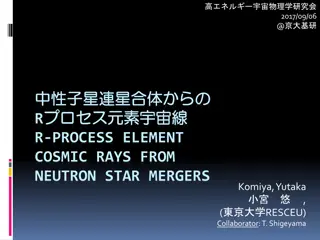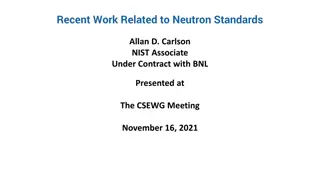Investigating Neutron Star PSR J1640-4631's Interior Physics
Delve into the unique properties of neutron star PSR J1640-4631, exploring its magnetic fields, tilt angle evolution, and implications for the interior physics of these fascinating cosmic objects. Discover how observational data and theoretical models shed light on the complex dynamics within this neutron star.
Download Presentation

Please find below an Image/Link to download the presentation.
The content on the website is provided AS IS for your information and personal use only. It may not be sold, licensed, or shared on other websites without obtaining consent from the author.If you encounter any issues during the download, it is possible that the publisher has removed the file from their server.
You are allowed to download the files provided on this website for personal or commercial use, subject to the condition that they are used lawfully. All files are the property of their respective owners.
The content on the website is provided AS IS for your information and personal use only. It may not be sold, licensed, or shared on other websites without obtaining consent from the author.
E N D
Presentation Transcript
What can PSR J1640-4631 tell us about the internal physics of this neutron star? : : 2019.6.27 2019.6.27
Outline: I. Introduction 1. NS magnetic fields and magnetic deformation 2. Tilt angle evolution II. Constraining the interior physics 1. Braking index-PSR J1640 2. Our model 3. Results III. Conclusion
1. NS magnetic fields and magnetic deformation 1) Neutron Star Magnetic fields Exterior magnetic field: dipole magnetic field+multipole magnetic field? Olausen & Kaspi, 2014, ApJS Interior magnetic field: poloidal-toroidal (toroidal-dominated?) (Braithwaite & Spruit, 2004, Nature)
2) Magnetic deformation: i) EOS ii) the magnetic configuration (GR+superconducting+multipole field) iii) the magnetic energy a) poloidal b) toroidal c) poloidal-toroidal twisted torus d) superconducting Bonazzola & Gourgoulhon, 1996, A&A Cutler, 2002, PRD Mastrano et al., 2011, MNRAS Mastrano & Melatos, 2012, MNRAS
2. Tilt angle evolution The first stage BV: damping freebody precession, increase GRR: aftermath of GW emission, decrease The second stage Crust and neutron superfluid have formed, Viscosity: core-crust coupling Consequence: ? = ?/?,?? ???????? ????????? Timescale ???= ??/?? e-vortex scattering: ?~??? ??? elastic dissipation: ?~??? Very uncertain! (Dall Osso et al. 2009, MNRAS)
Stochastic GW background from magnetars With the tilt angle evolutions involved, the SGWB from newly born magnetars could be changed if magnetars have B_t=10^17 G. (1) four parts in the spectra (2) high frequency suppressed a few hundred to 1000 Hz enhanced (Cheng et al. 2015, MNRAS)
Magnetar-powered SLSNe (Cheng et al. 2018, PRD)
II. Constraining the interior physics 1. Braking index PSR J1640 young pulsars with measured braking indices Models proposed: (1) MDR in plasma magnetosphere (Eksi et al. 2016, ApJ) (2) MDR+wind (Tong & Kou, 2017, ApJ) (3) MDR+GWE (de Araujo et al. 2016, JCAP) (4) MDR+field decay (Gao et al. 2017, ApJ)
2. Our model spin evolution (MDR+GWE) with dipole field decay involved tilt angle evolution (GWE reaction + damping of precession) To be constrained thus we have Related to field decay
Interior magnetic configuration and NS ellipticity proton superconductivity in the core poloidal-dominated toroidal-dominated (Lander 2013, PRL) (Akgun & Wasserman 2008, MNRAS)
The theory of magnetic field decay the exponential form the nonlinear form Hall drift dominate the field decay process Ohmic dissipation dominate, possible time scales are from thermal observations from theoretical calculations (core flux tube drift and crustal Ohmic dissipation) (Cumming et al. 2004; Pons et al. 2007; Dall Osso et al. 2012)
3. Our results poloidal-dominated toroidal-dominated i) would be larger than previous estimates unless a tiny angle? 5 is observed ii) future observation of using eXTP may constrain the internal magnetic field configuration Implications of large of : i) weak interactions in the NS interior; ii) weak GWEs of newborn magnetars. Cheng et al. 2019, PRD
III. Conclusion 1) would be larger than previous estimates unless a tiny angle? 5 is observed. 2) Future observation of using eXTP may constrain the internal magnetic field configuration.
